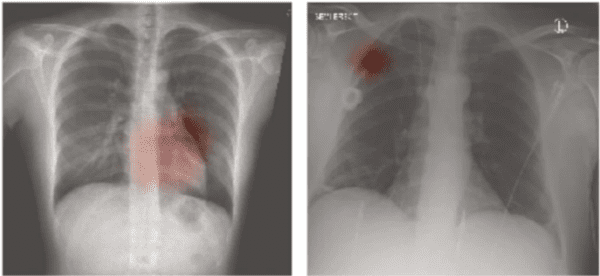|
Imaging’s Unseen Potential | Unprecedented Imaging IT
May 22, 2022
|
|
|

|
|
Together with
|

|
|
|
“Radiology really is population health.”
|
|
Ayis Pyrros, MD on radiology’s central role in the future of population health and value-based care.
|
|

|
|
Amid the dozens of imaging AI papers and presentations that came out over the last few weeks were three compelling new studies highlighting how much “unseen” information AI can extract from medical images, and the massive impact this information could have.
Imaging-Led Population Health – An excellent presentation from Ayis Pyrros, MD placed radiology at the center of healthcare’s transition to value-based care and population health, highlighting the AI training opportunities that will come with more value-based care HCC codes and imaging AI’s untapped potential for early disease detection and management. Dr. Pyrros specifically emphasized chest X-ray’s potential given the exam’s ubiquity (26M Medicare CXRs in 2021), CXR AI’s ability to predict outcomes (e.g. mortality, comorbidities, hospital stays), and how opportunistic AI screening can/should support proactive care that benefits both patients and health systems.
- Healthcare’s value-based overhaul has traditionally been seen as a threat to radiology’s fee-for-service foundations. Even if that might still be true from a business model perspective, Dr. Pyrros makes it quite clear that the shift to value-based care could make radiology even more important — and importance is always good for business.
AI Race Detection – The final peer-reviewed version of the landmark study showing that AI models can accurately predict patient race was officially published, further confirming that AI can detect patients’ self-reported race by analyzing medical image features. The new paper showed that AI very accurately detects patient race across modalities and anatomical regions (AUCs: CXRs 0.91 – 0.99, chest CT 0.89 – 0.96, mammography 0.81), without relying on proxies or imaging-related confounding features (BMI, disease distribution, and breast density all had ≤0.61 AUCs).
- If imaging AI models intended for clinical tasks can identify patients’ races, they could be applying the same racial biomarkers to diagnosis, thus reproducing or exacerbating healthcare’s existing racial disparities. That’s an important takeaway whether you’re developing or adopting AI.
CXR Cost Predictions – The smart folks at the UCSF Center for Intelligent Imaging developed a series of CXR-based deep learning models that can predict patients’ future healthcare costs. Developed with 21,872 frontal CXRs from 19,524 patients, the best performing models were able to relatively accurately identify which patients would have a top-50% personal healthcare cost after one, three, and five years (AUCs: 0.806, 0.771, 0.729).
- Although predicting which patients will have higher costs could be useful on its own, these findings also suggest that similar CXR-based DL models could be used to flag patients who may deteriorate, initiate proactive care, or support healthcare cost analysis and policies.
|




|
|
GE Healthcare’s Future Ready CT Platform
Check out this Imaging Wire Show featuring GE Healthcare’s CT and MI Chief Marketing Officer, Sonia Sahney, for an excellent conversation exploring GE’s platform-based approach to solving imaging teams’ scalability challenges.
|
|
Becoming Imaging AI Adopters
We talk a lot about radiology practices’ AI adoption, but usually don’t have much evidence to back it up. That changes with this new Arterys report detailing how and why 30 US radiology groups became imaging AI adopters.
|
|
- The 2022 Contrast Shortage: The iodinated contrast shortage remained medical imaging’s biggest story last week, making headlines across a wide range of news outlets and dominating radiology’s social media discussions. GE Healthcare since revealed that its Shanghai contrast facility has returned to 50% capacity, and it’s ramping up production at another global facility. GE is also allowing clients to source contrast from other vendors, some of which are actively working to meet demand. Until inventories rebound, here’s a good resource for how providers can manage the contrast shortage.
- Density & Benign Disease Risk Factor: A massive study out of South Korea added more evidence that women with dense breasts and benign breast disease face significantly higher future breast cancer risks. The researchers analyzed data from 3.9M women over a ~10.6-year follow-up period, finding that women with extremely dense breasts and benign breast disease at screening had far higher risk of breast cancer than women with fatty breasts and no breast disease (HR: 2.75). Meanwhile, women with benign breast disease and fatty breasts (HR: 1.49) and women with extremely dense breasts and no benign breast disease (HR: 2.28) also had higher breast cancer risks.
- Imaging IT’s Unprecedented Growth: Signify Research reports that imaging hardware supply chain challenges will suppress the global imaging IT market’s growth in 2022 (~2.5% in 2022 vs. ~4% in 2021), but forecast “unprecedented growth” in 2023 and 2024 (~4.5%/yr) driven by initiatives to improve imaging collaboration/productivity and new demand from the outpatient and ambulatory centers. Given imaging IT’s limited growth potential in most years, Signify advised vendors to start preparing to capitalize on 2023 and 2024’s unique growth opportunities.
- DECIDE-AI Reporting Guideline: A collection of AI and research leaders just rolled out the DECIDE-AI reporting guideline for the early-stage, live clinical evaluation of AI systems. Assembled with input from at least 138 experts, the DECIDE-AI guidelines feature 17 AI-specific reporting items and 10 generic reporting items that they believe will improve early-stage reporting quality and lead to higher impact large-scale trials.
- Google Hires Former FDA CDO: Google appointed the FDA’s former chief digital officer Bakul Patel to lead its global digital health and regulatory strategy. The hire looks like a clear sign that Google is getting more serious about its healthcare plans after reorganizing its Google Health division late last year. In a LinkedIn post announcing the move, Patel said that his “biggest northstar has been to make digital healthcare accessible and equitable for all,” a mission that’s well aligned with Google’s recently announced AI tools to improve early detection of complications with pregnancies and diabetes.
- CT Contrast Pooling & Cardiac Arrest: A new study out of Taiwan confirmed that CT contrast agent pooling (CAP) should be flagged as a sign of imminent cardiac arrest with a higher risk of poor outcomes. The researchers reviewed chest and abdominal CTs from 128-consecutive emergency department patients who later experienced cardiac arrest (11 CTs w/ CAP), finding that CAP in CT scans predicted which patients would experience cardiac arrest within one hour with 86% accuracy (7.35 adjusted odds ratio) and patients with CAP had far lower survival rates (0% vs. 15.4%).
- neuro42’s Neuro MRI Robot: neuro42 announced a licensing agreement with Johns Hopkins University, giving the point-of-care neuro MRI startup exclusive rights to Johns Hopkins’ MR-compatible robot for head, neck, and spine applications. The robot performs targeted needle insertion with precision depth control, and will be incorporated with the neuro42 MRI system to support image-guided interventions during brain biopsies, shunt placements, and laser ablations.
- Advocate Aurora + Atrium: Regional health systems Advocate Aurora Health and Atrium Health are merging to create one of the largest nonprofit health systems in the US, spanning 67 hospitals with $27B in combined revenue. The new system, called Advocate Health, gave a list of six key focus areas that the merger will support, which doubles as a cheat-sheet for anyone wondering about current health system priorities: clinical pre-eminence and safety, health equity, affordability, next-generation workforce, learning and discovery, and environmental sustainability.
- PCa Scores Align: A new study in Clinical Radiology showed that prostate cancer MRI assessments using the PI-RADS and Likert scoring systems are largely equivalent, while adding evidence that most men with negative prostate MRI findings can avoid immediate prostate biopsies. The study compared PI-RADS and Likert scores from 323 men with suspected prostate cancer, finding high concordance rates across the entire cohort (87%), among men with negative MRI results (99%), and men with 5 PI-RADS/Likert scores (96%). The only discordance was with the PI-RADS 4 group, 32% of whom were up-risked to Likert 5.
- Olympus & Bracco EUS Alliance: Olympus and Bracco Diagnostics launched a U.S. co-marketing alliance intended to expand the use of contrast-enhanced endoscopic ultrasound (EUS) for the characterization of focal liver lesions. Through the alliance, Olympus will offer Bracco’s Lumason ultrasound agent with its EUS systems, while the companies will collaborate to increase usage and awareness of the emerging diagnostic approach.
- AI + Reader Improvements: A Frontiers in Oncology study highlighted mammography AI’s ability to improve less-experienced radiologists’ performance with malignant architectural distortions (AD). The researchers had three general and three breast radiologists interpret exams from 267 patients as part of a double reading workflow (177 w/ malignant ADs). Working without AI, the three breast radiologists (AUCs: 0.875, 0.882, 0.884) outperformed the general radiologists (0.733, 0.652, 0.655) and the AI algorithm (0.792). However, AI support significantly improved the overall performance of the general rads (0.880 vs. 0.680), and improved the accuracy of the breast rads (0.893 vs. 0.880) and the double-reading consensus (0.908 vs. 0.878).
|
|
Improving Your Radiology Workflow
Having Trouble Improving Your Radiology Workflow? This Novarad report details how a customizable PACS, high uptime and reliability, and digital image enhancement tools can improve your workflow.
|
|
- The USPSTF guidelines for lung cancer screening were updated in May 2021, and driving compliance to such guidelines is a long, slow, repetitive process. Because of that, the Riverain team put together a kit to help hospitals and imaging centers educate either referring physicians or patients on the new guidelines either via branded tools or through the media.
- The future of radiology starts on June 30th. Reserve your spot for AI Visions 2022, featuring live discussions from the top radiology and AI leaders and the global launch of Bayer’s Calantic Digital Solutions AI marketplace.
- Check out this Change Healthcare video explaining the difference between single-tenant and multitenant cloud architecture, and how multitenant solutions can improve your efficiency and flexibility.
- Pediatric patients can’t always accurately describe their orthopedic-related pain. Read how Lorenzo Biassnoi, MD, describes how SPECT/CT can help in this SPECT/CT and pediatric orthopedic surgery story.
- Us2.ai recently announced the global launch of its flagship echocardiography AI solution, leveraging a new $15M Series A round, and its unique abilities to completely automate echo reporting (complete editable/explainable reports in 2 minutes) and analyze every chamber of the heart (vs. just left ventricle with some vendors).
- Learn how Memorial MRI and Diagnostics’ efforts to improve its MRI patient experience impacted its patient referrals, clinical case mix, throughput, and accessibility in this June 1st webinar by United Imaging and AuntMinnie.com.
- Faced with the task of monitoring the thousands of exams its algorithms analyze each day, Qure.ai leveraged CARPL.ai’s validation workflow to create a real-time performance dashboard. See how they did it here.
- Check out this Imaging Wire Show interview with Blackford Analysis founder and CEO, Ben Panter, detailing how to solve AI’s assessment and deployment problem, AI’s downstream value, and what it will take for AI to have its greatest impact.
- Women’s imaging has come a long way, but operational efficiency remains a challenge for many facilities. To help address this challenge, this Fujifilm post details the five questions women’s imaging facilities should ask when evaluating workflow management solutions.
- Check out this editorial by Nuance EVP Peter Durlach on how AI-augmented diagnostic imaging is driving new approaches to collaborative, patient-specific precision care.
|
|
|
|
|